
Drinking Up the Possibilities of Water Reclamation
- By Elizabeth Freed
- Mar 06, 2012
As the world population grows, the struggle to provide enough resources to people becomes paramount. Whether it is having access to a resource or having enough of it, nations will fight to gain control of supply. Of those resources, one of the most vital is water.
According to the World Health Organization, almost one-fifth of the world's population (about 1.2 billion people) has no source of freshwater in their proximity. In addition, one-quarter of the global population also live in countries that face water scarcity because of a lack of infrastructure to transport water from rivers and aquifers.
In total, one in three people do not have potable freshwater to meet their daily needs. Freshwater is limited on this planet since most of the water supply is saline. Not only is the supply of freshwater under strain because of growing need, but the quality is constantly threatened by pollution. Using unsafe water for drinking, cleaning and bathing can lead to life-threatening diseases like cholera and dysentery.
In the United States, different municipalities have employed various strategies to address the growing water shortage. Depending on location, availability and technology, public partnership projects choose what works best to augment their supply of groundwater and surface water.
One of the most common technologies used is reverse osmosis. In reverse osmosis (RO), water is pumped at extremely high pressures through very fine plastic membranes. These mesh filters capture most of the microscopic matter that makes water non-potable such as bacteria and pharmaceuticals.
Another technique is microfiltration. Water is forced into hollow tubes through holes that are 1/300 the diameter of a human hair on the side of the tubes. Solids, protozoa and some viruses are then trapped outside the tube. This is often done prior to RO since it uses a similar concept, but has more porous holes. Therefore, it tends to trap larger contaminants in the water.
Additionally, UV light and hydrogen peroxide can aid the purification process. Water is exposed to the light and oxidation in order to sanitize any remaining contaminants. These processes can be used individually or in conjunction to turn wastewater, brackish water or seawater into drinking water from the faucet.
Groundwater Replenishment System (GWRS) is a project of the Orange County Water District and the Orange County Sanitation District. The system uses all three of the above processes to make wastewater drinkable. This provides Orange County residents with 70 million gallons per day of water.
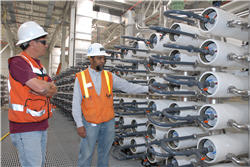 Orange County Water Disctrict workers assess reverse osmosis (RO) filters for maintenance.
Orange County Water Disctrict workers assess reverse osmosis (RO) filters for maintenance.
Mehul Patel, a GWRS Program Manager and OCWD Principal Engineer, said that the water quality limits in California for reclaimed wastewater are stricter than for regular sources of potable water.
The project claims that processed water is near distilled in quality. So many minerals are removed through the procedures that minerals are actually added in the end to make the water drinking quality. Also, water purified through these operations is easier and faster to obtain than saltwater desalination and cheaper than transporting water over great distances.
“Places like California, Texas and the Southwest where water supplies are not enough for current or future demand will need to invest in wastewater reclamation,” said Patel who has worked in water utilities for 15 years. “Wastewater requires more advanced processes to decontaminate, but we haven’t had any problems or positive contaminant results. We are one of three plants in this area that are meeting these standards for drinking water.”
The Tampa Bay Seawater Desalination Plant uses extensive reverse osmosis systems to desalinate ocean water that is first pulled from the bay to cool a power station then partially routed to be treated. The disposal solution with twice as high salt concentrations is then blended with some of the original bay water used for cooling before returning to the bay. Extensive monitoring ensures that the bay’s salt levels do not rise too high.
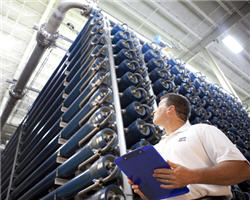 Tampa Bay Water's reverse osmosis membranes stack up to get the salt out of seawater.
Tampa Bay Water's reverse osmosis membranes stack up to get the salt out of seawater.
“Desalinated seawater is the drought-proof component of our integrated water system, in which three sources work together to create a reliable water supply for the Tampa Bay region,” said Chuck Carden, Director of Operations and Facilities at Tampa Bay Water.
El Paso Water Utilities (EPWU) has the largest municipal partnership with the Department of Defense through its Kay Bailey Hutchison Desalination Plant. It is the largest inland desalination plant in the world, producing nearly 27.5 million gallons per day. Ft. Bliss partnered with the city to offset the depletion of local sources of surface and groundwater.
The Desalination Plant only uses reverse osmosis (RO) to convert brackish water into potable water. Brackish water has a salt content that makes it unfit to drink, but it has a much lower saline content than seawater. In addition to depleted sources, El Paso faces the danger that brackish water could contaminate its fresh water stores.
By treating the salty water, the brackish water table stays low enough that it does not pose a threat to fresh groundwater. However, the concentrate that remains after treatment must be injected deep underground in porous rock, which can only be accommodated for 50 years at safe levels, assuming the plant is always running at full capacity.
To prepare for the completion of surface injection, EPWU has researched alternative methods of disposing of the salt- and silica-rich concentrate. The most viable alternative found is the ability to crystallize the concentrate after repeatedly filtering it. In other words, the more the discarded solution is forced through RO membranes, the more concentrated with minerals it becomes. This can then be converted to a solid to either be trashed in a landfill or possibly used to make construction materials like wallboard.
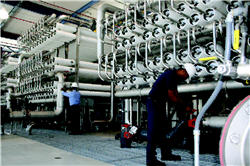 Water is pumped through RO membranes at an incredibly high pressure, which requires constant supervision of equipment at El Paso Water Utilities.
Water is pumped through RO membranes at an incredibly high pressure, which requires constant supervision of equipment at El Paso Water Utilities.
“It’s important in any arid situation to get as much use of the water as possible,” said John Balliew, Vice President of Operations and Technical Services for EPWU. “Essentially, what we’ve done is drastically reduced the volume of concentrate and squeezed out more water by purifying it over and over again.”
The plant currently puts out three million gallons per day of concentrate solution, but the new process could reduce that amount to half a million gallons per day. Balliew, who has spent 29 years in water utilities, emphasizes that wastewater is the most important water purification project for most communities that don’t have access to saline water. The Fred Hervey Water Reclamation Plant in El Paso produces 10 million gallons of potable water per day.
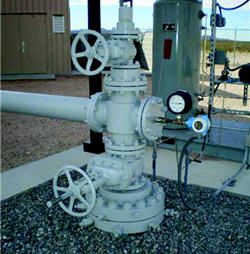 The Kay Bailey Hutchison Desalination Plant uses pumps like these to inject concentrated waste solution deep underground.
The Kay Bailey Hutchison Desalination Plant uses pumps like these to inject concentrated waste solution deep underground.
Other processes that were once cost-prohibitive are improving and becoming more accessible. In a newly patented technology developed by R3 Fusion, a thermal approach is used to evaporate very low total dissolved solids (TDS) water from contaminated or briny fluids. The unique design characteristics of the Short Path Condensate Recovery (SPaCeR) equipment allow for an energy-efficient means to evaporate clean water from a contaminated source at commercial volumes.
“We believe that this is a game-changing approach to water purification and treatment although it will most likely find its greatest use as part of an overall systematic approach to the water challenge,” said CEO Keith Blakely.
Since the evaporation method does not perform as well on larger contaminants, but is highly effective for dissolved solids, it would be well-positioned downstream from a treatment plant. The result would be similar to the was Orange County Water District currently uses UV and Hydrogen Peroxide treatment.
Blakely continued, “The increasing demand on our very limited supply of fresh water globally that results from both increasing populations and increased consumption due to industrial activity (including energy production such as fracking) will continue to increase the significance of cost-effective, energy-efficient and portable means of water purification.”
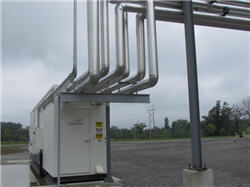 25 MM gallon per year SPaCeR system in operation in Upstate NY.
25 MM gallon per year SPaCeR system in operation in Upstate NY.
About the Author
Elizabeth Freed is an Associate Content Editor for 1105 Media Inc.